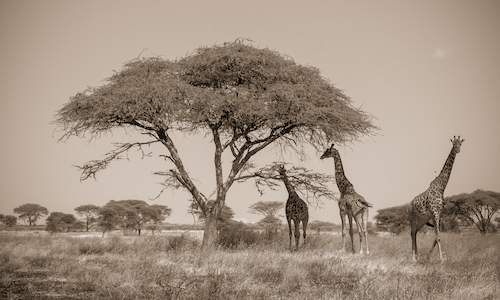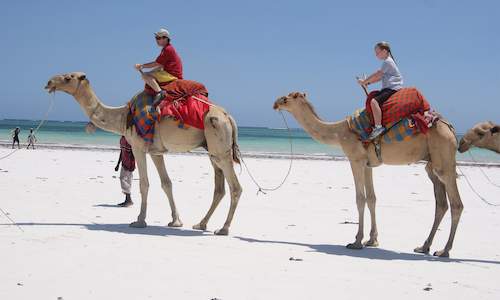Kilwa Kisiwani Ruins
The Ancient Port City of East Africa
© The ramparts of Kilwa Kisiwane Ruins
Review by Graeme Field
I stand amidst the bustling chaos, allowing the cacophony of noise to wash over me. The clamour is loud and colourful but yet strangely organised, a myriad sounds combined into one lively and continuous drone. I begin to isolate specific sounds, my ears identifying their source and my eyes seeking it out as I slowly absorb all that is going on around me. Here in the heart of the marketplace the noises are sharp and busy with the endless clatter of people going about their daily business.
Vendors vying for the attention of the buyers shout over one another, their animated voices
a mix of Arabic, Portuguese and French. Others haggle and barter over the prices of the oriental spices, ornately carved ivory, expensive Indian silks and beautifully coloured glass beads that are spread out on Persian rugs along the sides of the dusty streets.
Further away I detect the dull thud of construction as the boat builders drive long brass nails into wooden hulls. I let my gaze wander out over one of the finest natural
harbours in east Africa to where fleets of dhows lie at anchor in the shimmering waters of the bay. These are majestic vessels - sleek and powerful fighting dhows, heavily laden trading vessels and local fishing boats - symbols of a thriving economy. Further out, moored away from the rest of the fleet, lie the dark, evil and diseased slave-trading dhows, the unmistakable putrid stench of human misery occasionally wafting up on the morning breeze.
On the beach their human cargo forms a living conveyor belt of glistening black bodies transporting a steady stream of lavish supplies to the Sultans, watched over by the hawk-eyed sentries standing guard high atop the thick, impenetrable walls of the impressive stone fort.
My attention is drawn to a commotion in the far corner of the market square and I push through the throng of people to investigate the cause of the disturbance. As I draw nearer I can hear the clanging of metal chains, the sharp
cracking of whips and angry shouting. Ahead of me the crowds part and I stare mesmerised at the line of manacled, emaciated humans, their eyes hollow with pain and infinite sadness. It's a new slave caravan, arriving in the port-city weak and wasted after weeks of slow and painful trekking through the African interior.
Already the French traders are inspecting the human wares, seeking out the strongest and fittest to work on their sugar plantations on the French occupied islands of Reunion and Mauritius. This is no place for the weak as they are weeded out, tossed aside and left for dead, like the hundreds that dot the long and arduous slave routes that wind westwards into the harsh interior.
It's cruel and brutal time, an era of ruthless Arabic dominance when the rich and powerful Sultans ruled the lucrative Indian Ocean islands and trade routes,
controlling the flow of gold, ivory and slaves to Europe and beyond. I'm fascinated and intrigued by this ancient world that is alive around me, but reluctantly I draw my mind back through the centuries, the colours, sounds and smells quickly receding until I find myself standing once again amongst the dull grey stone of the ruins of Kilwa Kisiwane, the ancient port city of the east African coast.
I like to do this when I find myself in a place of such diverse and interesting history. I shut my eyes and let my mind wander back through the years as I bring the place to life, letting my imagination run wild as I try to picture that small part of the world so very long ago.
Of what was once a thriving and prosperous city and the stronghold of the African coast, well preserved stone ruins are now all that remain, scattered between a quiet and peaceful Swahili fishing village. Ruled by many countries over ten or more centuries, the area has a colourful and bloody past,
an erratic and extreme history of great wealth and stunning economic collapse, with many civilisations having had an influence on the historic ruins that remain today.
Kilwa Kisiwani is a mangrove lined island that lies a kilometre from the coastal town of Kilwa Masoko in southern Tanzania, a mere hour's flight south of the capital Dar-es-Salaam. The flight down the coast is spectacular and takes you along the ancient sailing routes, over numerous inviting looking islands and atolls, across the mouth and deltas of the mighty Rufiji River before touching down near magnificent mangrove water ways that stretch out from the mouth of a large bay. Across this bay lies
the island of Kilwa Kisiwani and the ruins, the large stone fort clearly visible on the northern point of the island.
Kilwa Kisiwane was the principal settlement on
the East African coast. While it was settled as far back as the ninth century it first came to power in the 11th century, and by the beginning of the 14th century it was a powerful and prosperous settlement, ruled by an independent African Sultanate.
It's location at one of the best natural harbours along the coast meant that it controlled the lucrative ocean trade routes along a considerable stretch of the East African coast and neighbouring islands, it's great wealth stemming from trade in valuable commodities. From the east came expensive fabrics and precious Chinese ceramics; from the long and dangerous routes from the African interior porters delivered ivory, resins, rhino horn, animal skins and tortoise shell, and from the Zimbabwean plateau came
a rich supply of gold. Kilwa acted as the depot where all of these goods were stored, before being bought and sold by the ocean merchants. To the inland traders Kilwa supplied treasured coastal goods such as cowrie shells, local cotton fabric and beads, as well as items shipped in from abroad.
The city's somewhat erratic history of economic rise and fall is linked directly to its ability to control that trade. It's 14th century prosperity was short-lived and the islands economy crashed dramatically as a direct influence of the outbreak of Black Death in Europe in 1362, which resulted in a sharp fall in world gold prices. However, Kilwa recovered well in the 15th century when it was rebuilt, before being overthrown by the Portuguese in 1498. A year later the Omanis attacked the Portuguese holdings and
the island changed hands once again. It was around this time that the slave trade boomed and the island prospered, but it was short lived and due to political reasons the economy rapidly deteriorated. By the mid 1800's Kilwa Kisiwane was a mere shadow of it's past and it never recovered.
Today it is isolated and remote, but the ruins with their Arabic, Portuguese and Swahili influences make for a fascinating and interesting visit. Declared
a UNESCO world heritage site in 1981, the ruins that remain standing are largely of Arabic influence, the earliest being the Great Mosque which dates back to the 11th century. The mosque is surprisingly well preserved, the impressive and intricate pale cream coloured arches still stand tall, and the domed roof is still intact. The stone fort and Sultan's palace, various residences and a number of tombs and graves dot the lush green island, and with a bit of imagination one can piece together the once thriving city.
If you find yourself in the area as a guest at one of the nearby lodges, then I highly recommend that you pay this island a visit. You will need a permit which is easily obtained, and be sure to take along a local Swahili as their enthusiasm for reliving the history is infectious. Kilwa Kisiwani epitomises everything that is the East African coastline, and a few hours spent wandering around these
well preserved ruins will bring its long and colourful history to life.

Tanzania Natural Heritage Sites include the Ngorongoro Conservation Area, Serengeti National Park, Selous Game Reserve and Kilimanjaro Natio...
more
For the average tourist, a visit to Tanzania usually involves jetting in for a whistle-stop safari then zipping off to Zanzibar for a few da...
more


 Tanzania Natural Heritage Sites include the Ngorongoro Conservation Area, Serengeti National Park, Selous Game Reserve and Kilimanjaro Natio...
Tanzania Natural Heritage Sites include the Ngorongoro Conservation Area, Serengeti National Park, Selous Game Reserve and Kilimanjaro Natio... For the average tourist, a visit to Tanzania usually involves jetting in for a whistle-stop safari then zipping off to Zanzibar for a few da...
For the average tourist, a visit to Tanzania usually involves jetting in for a whistle-stop safari then zipping off to Zanzibar for a few da...